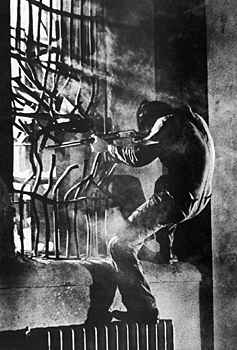
A guard's bullet kills an inmate during
a prison riot in Birdman of Alcatraz.
Other Themes
Of course many other themes are prevalent in prison films -- not least of which is the prison escape documented in films such as Prison Break (1938), Crashout (1955), Breakout (1975) and, perhaps most memorably Midnight Express (1978). The constant battle with authority also punctuates most prison films. Inmate defiance has been central to the prison movie. Robert Stroud's refusal to be institutionalised in Birdman Of Alcatraz (1962) is a prime example of such a battle. Stroud is locked in a constant struggle throughout the film with the Governor, culminating in Stroud's tirade against the prison system:
|
